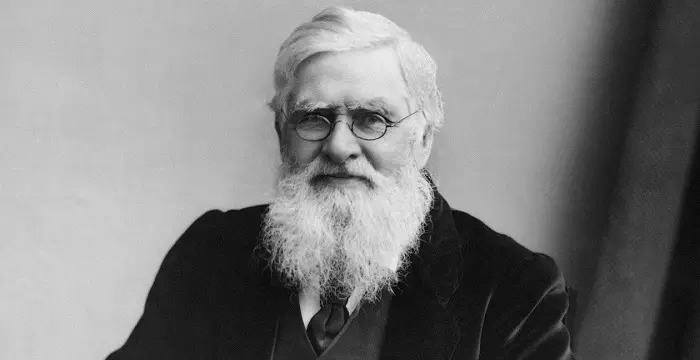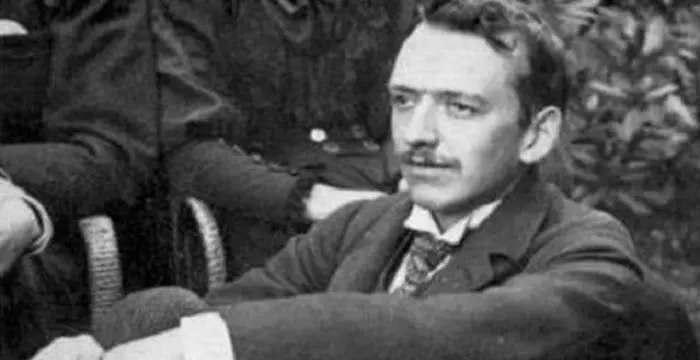
William Morris Davis - Geographers, Family and Family
William Morris Davis's Personal Details
William Morris Davis was an American geographer, geologist, and meteorologist, who founded the science of geomorphology
| Information | Detail |
|---|---|
| Birthday | February 12, 1850 |
| Died on | February 5, 1934 |
| Nationality | American |
| Famous | Intellectuals & Academics, Geographers, Geologists, Meteorologists |
| Birth Place | Philadelphia, Pennsylvania, United States |
| Gender | Male |
| Father | Edward M. Davis |
| Sun Sign | Aquarius |
| Born in | Philadelphia, Pennsylvania, United States |
| Famous as | Geographer, Geologist, Meteorologist |
| Died at Age | 83 |
// Famous Intellectuals & Academics
Bertil Gotthard Ohlin
Bertil Gotthard Ohlin was a famous Swedish economist. This biography profiles his childhood, family life & achievements.
Emily Greene Balch
Emily Greene Balch was an American economist, sociologist and pacifist who won the 1946 Nobel Peace Prize. This biography of Emily Greene Balch provides detailed information about her childhood, life, achievements, works & timeline.
Martin Buber
One of the greatest philosophers to have ever walked on earth, Martin Buber contributions to philosophy is a long-standing one. Explore all about his profile, childhood, life and timeline here.
William Morris Davis's photo
Who is William Morris Davis?
William Morris Davis was an American geographer, geologist, and meteorologist, who founded the science of geomorphology—the study of landforms. He is often referred to as the “Father of American Geography”. He began his career as a meteorologist with the national Observatory at Córdoba, Argentina, and in three years, acquired a position with Harvard University, where he continued his employment for the next 36 years. Quite early in his career, he became interested in the study of landforms. His publication ‘The Rivers and Valleys of Pennsylvania’ (1889) introduced the ‘Davisian system’ of landscape analysis, which became his most celebrated work in physical geography. In this publication, he suggested that the physical features of the land are the consequence of a long term, continual erosion and that this sequential change through time was made of a cycle of erosion, which according to him was crucial in understanding the present landscape and geological history. Post retirement, he became a visiting lecturer to several universities, dedicated many hours to writing and field studies, and conducted in-depth researches of coral reefs and coral islands; the learnings of which were published in ‘The Coral Reef Problem’ (1928). During his lifetime, he published more than 500 works on Geography.
// Famous Geologists
Robert Ballard
Dr. Robert Ballard is the founder of the Ocean Exploration Center and specializes in deep-sea archeology. This biography contains information about his childhood, life, achievements & timeline.
Charles Darwin
Charles Darwin was one of the most influential figures in human history. Go through this biography to get details about his life, profile and timeline.
Birbal Sahni
Birbal Sahni was an Indian palaeobotanist who founded the Birbal Sahni Institute of Palaeobotany in Lucknow. This biography of Birbal Sahni provides detailed information about his childhood, life, achievements, works & timeline.
Childhood & Early Life
William Morris Davis was born on 12 February 1850, in Philadelphia, Pennsylvania. His father, Edward M. Davis, was a businessman and his mother’s name was Maria Mott Davis. His maternal grandmother, Lucretia Mott, was a women’s rights and anti-slavery activist.
Both his parents were members of the Society of Friends. Eventually, his father was disqualified from the society for joining the Union Army during the War Between the States. Before long, his mother also gave up her membership.
As a boy, he was not much interested in sports, rather he was more absorbed in his studies. For many years he was home schooled by his mother; this laid the foundation of a flawless vocabulary and his firmness for accurate writings by his students.
He was a bright student and at the age of nineteen, he graduated with a Bachelor of Science degree from Harvard University. He received a Master of Engineering degree a year later in 1870.
Career
Right after receiving his Masters’ degree, William Morris Davis joined as a meteorologist at the Córdoba Observatory in Argentina. After three years, he returned to the United States and served as a field assistant to Raphael Pumpelly, on the Northern Pacific survey.
In 1877, he joined Nathaniel S. Shaler, the professor of Geology at Harvard College, as his assistant. It was under him, that he developed an everlasting love for geography.
Since promotion was slow in those times, he was listed as an instructor in Geology at Harvard from 1879 to 1885. In 1885, he was appointed Assistant Professor of Physical Geography.
In 1889, he published the ‘The Rivers and Valleys of Pennsylvania’, which became his most important work in physical geography. In this publication, he introduced the concept of the ‘Davisian system’ of landscape analysis.
The analysis denotes that the physical features of the land are the result of long term continual erosion. This sequential change through time is what makes ‘a cycle of erosion’, a concept which according to him is extremely crucial in understanding current landscape and geological history.
In 1890, he became full Professor of Physical Geography and nine years later in 1898, he was appointed the Harvard Sturgis Hooper Professor of Geology. In 1912, he resigned from his responsibilities and became a Harvard ‘emeritus’ for the rest of his life.
During his Professorship at Harvard, he had two leaves of absence. In 1908, he was appointed Visiting Professor at Berlin University for a year, and in 1911, he was Visiting Professor at Paris for a year. In France, he also lectured at various provincial universities.
After he retired from his duty at Harvard, he engaged more in field studies and writing. He studied the development of coral reefs and coralline islands. His long monograph ‘The Coral Reef Problem’ (1928) contained the findings of detailed studies conducted in south-western Pacific and the Lesser Antilles.
He also served as a Visiting Lecturer at the University of California at Berkeley from 1927 to 1930, the University of Arizona from 1927 to 1931, Stanford University from 1927 to 1932, the University of Oregon in 1930, and the California Institute of Technology from 1931–1932.
Major Works
In ‘The Rivers and Valleys of Pennsylvania’ (1889) and its sequel, ‘The Rivers and Valleys of Northern New Jersey, With Notes on the Classification of Rivers in General’ (1890), he laid the foundation of his method of landscape analysis (the Davisian System) and defined ‘the cycle of erosion’.
His other most important work was his study of the Triassic basins of New England and New Jersey, supported by the U.S. Geological Survey. The first report was published in 1882 while the final and all-encompassing one, ‘The Triassic Formation of Connecticut’ was published in 1898.
Awards & Achievements
William Morris Davis received honorary degrees from the universities of the Cape of Good Hope, Melbourne, Greifswald, and Christiana (Oslo). He was also an honorary member of more than thirty scientific societies across the world.
He was a founding member of the Geological Society of America and was its acting President in 1906 and President in 1911. He played a key role in establishing the Association of American Geographers and served as its President in 1904, 1905, and 1909.
He was a member of the American Academy of Arts and Sciences, the American Philosophical Society, the National Academy of Sciences, the Imperial Society of Natural History (Moscow), and the New Zealand Institute.
Personal Life & Legacy
William Morris Davis was married thrice, and unfortunately, lost his wife twice. He married Ellen B. Warner of Springfield, Massachusetts in 1879. After she expired, he married Mary M. Wyman of Cambridge, Massachusetts in 1914. When his second wife also died, he married Lucy L. Tennant of Milton, Massachusetts in 1928, who outlived him.
He died on 5 February 1934, in Pasadena, California, a few days before his 84th birthday.
His Cambridge home is a National Historic Landmark. The valley of Davisdalen in Nathorst Land at Spitsbergen, Svalbard is named after him.
// Famous Geographers
Jabir Ibn Hayyan
Jabir Ibn Hayyan was a medieval era polymath. Check out this biography to know about his life, works and achievements.
Hipparchus
Hipparchus was a Greek astronomer and mathematician. This biography profiles his childhood, life, achievements and timeline.
Alfred Russel Wallace
Alfred Russel Wallace was a British scientist and explorer, best known for discovering the concept of evolution by natural selection. This biography of Alfred Wallace provides information about his childhood, life, achievements, works & timeline.
William Morris Davis's awards
| Year | Name | Award |
|---|---|---|
Other | ||
| 0 | 1919 - Patron's Gold Medal | |
| 0 | 1931 - Penrose Medal | |
William Morris Davis biography timelines
- // 12th Feb 1850William Morris Davis was born on 12 February 1850, in Philadelphia, Pennsylvania. His father, Edward M. Davis, was a businessman and his mother’s name was Maria Mott Davis. His maternal grandmother, Lucretia Mott, was a women’s rights and anti-slavery activist.
- // 1870He was a bright student and at the age of nineteen, he graduated with a Bachelor of Science degree from Harvard University. He received a Master of Engineering degree a year later in 1870.
- // 1877In 1877, he joined Nathaniel S. Shaler, the professor of Geology at Harvard College, as his assistant. It was under him, that he developed an everlasting love for geography.
- // 1882 To 1898His other most important work was his study of the Triassic basins of New England and New Jersey, supported by the U.S. Geological Survey. The first report was published in 1882 while the final and all-encompassing one, ‘The Triassic Formation of Connecticut’ was published in 1898.
- // 1889In 1889, he published the ‘The Rivers and Valleys of Pennsylvania’, which became his most important work in physical geography. In this publication, he introduced the concept of the ‘Davisian system’ of landscape analysis.
- // 1889 To 1890In ‘The Rivers and Valleys of Pennsylvania’ (1889) and its sequel, ‘The Rivers and Valleys of Northern New Jersey, With Notes on the Classification of Rivers in General’ (1890), he laid the foundation of his method of landscape analysis (the Davisian System) and defined ‘the cycle of erosion’.
- // 1908 To 1911During his Professorship at Harvard, he had two leaves of absence. In 1908, he was appointed Visiting Professor at Berlin University for a year, and in 1911, he was Visiting Professor at Paris for a year. In France, he also lectured at various provincial universities.
- // 1928After he retired from his duty at Harvard, he engaged more in field studies and writing. He studied the development of coral reefs and coralline islands. His long monograph ‘The Coral Reef Problem’ (1928) contained the findings of detailed studies conducted in south-western Pacific and the Lesser Antilles.
- // 5th Feb 1934He died on 5 February 1934, in Pasadena, California, a few days before his 84th birthday.
// Famous Meteorologists
Charles Thomson Rees Wilson
Charles Thomson Rees Wilson was a Scottish meteorologist and physicist. This biography of Charles Thomson Rees Wilson provides detailed information about his childhood, life, research, achievements and timeline.
William Morris Davis's FAQ
What is William Morris Davis birthday?
William Morris Davis was born at 1850-02-12
When was William Morris Davis died?
William Morris Davis was died at 1934-02-05
Which age was William Morris Davis died?
William Morris Davis was died at age 83
Where is William Morris Davis's birth place?
William Morris Davis was born in Philadelphia, Pennsylvania, United States
What is William Morris Davis nationalities?
William Morris Davis's nationalities is American
Who is William Morris Davis's father?
William Morris Davis's father is Edward M. Davis
What is William Morris Davis's sun sign?
William Morris Davis is Aquarius
How famous is William Morris Davis?
William Morris Davis is famouse as Geographer, Geologist, Meteorologist











